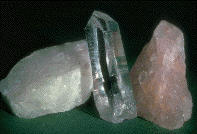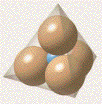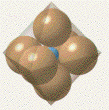What Element Has 20 Neutrons

States of Matter
- Annihilation that has mass and occupies space is matter. The following classification volition aid define the states in which matter can occur.
- Solid - rigid substance that retains its shape unless distorted by a force
- Crystalline Solid - equally above and the structure (distribution of the components) is highly regular and repetitive - long range order
- Non-Crystalline Solid - equally above but the structure exhibits a short range order - drinking glass is an non crystalline or amorphous solid
- Liquid - flows and conforms to the shape of its container - short range order
- Gas - flows easily and expands to fill its container - disordered structure
- is a crystalline solid
- is naturally occurring
- is inorganic - non formed as role of a life procedure
- has a fixed chemical composition or a limerick that varies over a known extent
Structure of an Cantlet
- All matter is made up of chemical elements, each of which is made upwards of particles called atoms. A rather rough, but useful, picture of an cantlet is that of a rigid sphere. The radii of these atoms are a few angstroms (where an angstrom is 10-10 cm. There are 92 so-called naturally occurring elements of which 90 tin exist detected on Earth at this time. What happened to the "missing ii" volition be left for you to retrieve about.
- protons which deport a positive accuse and
- neutrons which are neutral (no accuse)
For our purposes we will ignore quarks and other particles that we would encounter if this were a upper level physics course.
These spheres contain a central nucleus which contains two types of particles:
The atomic number is the number of protons in the nucleus of the cantlet. The atomic mass number is the number of protons plus neutrons in the nucleus. All atoms of an element have the same number of protons - hence the same diminutive number; for example all atoms of hydrogen have one proton in the nucleus. Each chemical element is assigned a symbol - H for hydrogen. Y'all should larn the symbols for the eight well-nigh arable elements in the Earth'due south crust [Oxygen (O), Silicon (Si), Aluminum (Al), Calcium (Ca), Fe (Fe), Magnesium (Mg), Sodium (Na), and Potassium (One thousand)] .
- Calcium is atomic number 20. Therefore,
There are 20 neutrons in the nucleus of a Calcium atom
There are 20 protons in the nucleus of a Calcium atom
A Calcium atom weighs 20 atomic mass units
If we could weigh individual atoms of calcium we would observe some variation in their mass; this must exist due to variations in the number of neutrons in their nucleus every bit all must have the same number of protons - twenty. Atoms which have the same atomic number but different mass numbers are isotopes. For example, all calcium atoms have an atomic number of twenty just there are three isotopes of calcium - 39, 40, and 42. (How many neutrons does each isotope possess?)
- A calcium atom is found with a mass of 42. Therefore,
in that location are 20 protons and 22 neutrons in its nucleus
there are 20 neutrons and 22 protons in its nucleus
there are 20 protons and 42 neutrons in its nucleus
In addition to the particles in the nucleus, there are negatively charged particles - electrons which "orbit" the key nucleus. Recognition that the distribution of electrons effectually the nucleus is not random was one of the bully accomplishments of physicists in the 1920s - quantum mechanics.
Electrons occupy "levels" which are separated from each by some volume of space which electrons tin can pass through but non remain. In fact, much of the volume of an cantlet consists of empty infinite. [I call up that this is how Superman was able to pass through solid objects!] Electrons are "attracted" to the nucleus (positive and negative charges concenter).
The chief division of these levels is called the principal quantum number. The starting time level (Chiliad) is closest to the nucleus. As the principal number increases 1...ii....three....4 the number of electrons that can reside in the level increases.
| Level | Electrons |
|---|---|
| K | two |
| L | eight |
| M | eighteen |
| North | 32 |
In a neutral atom the number of negative particles equals the number of positive particles (electrons = protons).
- A cantlet of calcium has 20 neutrons. Therefore,
its mass number is twoscore
there are twenty protons in its nucleus
in that location are twenty electrons surrounding is nucleus
all of the above are correct
A useful do is to showtime with the kickoff element (Hydrogen) with its one proton and i electron and add protons and electrons to build up the remaining chemic elements. The build-up procedure works every bit follows. Start with a unmarried electron - it occupies the empty level closest to the nucleus. The second electron goes into the showtime level (atomic Helium) and the shell K) is filled. Actually, there are sub levels within the chief level (except for the K-shell).
| Sub Shell | Max Electrons |
|---|---|
| s | ii |
| p | half-dozen |
| d | 10 |
| f | 14 |
- If one electron is removed from a sodium atom
there is one more than negative charge than positive charge : -1
in that location is 1 more positive accuse than negative charge : +1
| Primary Level | Orbitals |
|---|---|
| Thousand | 1s (max = ii) Total = 2 |
| L | 2s (max = 2), 2p (max = half-dozen) Total = eight |
| One thousand | 3s (max = ii), 3p (max = six), 3d (max = ten) Total = eighteen |
An ion is a charged atom; that is, at that place is an excess of positive (cation) or negative charge (anion). If an electron is removed a cation is formed. If an electron is added an anion is formed. Of the eight most abundant elements in the World'southward crust only Oxygen forms anions; the residue class cations by loosing one or more than electrons. When there are 8 outer near electrons in the s and p sub shells the atom has a tendency to resist change and ions are formed with great difficulty if at all.
- An atom of element Z has 40 protons. Therefore, the outer nearly, valence electrons are in which main shell?
K
L
M
Due north
- How many of the 40 electrons are in the outer most level?
12
ten
22
40
Chemic Bonding
- Nearly elements in the Earth react to form compounds although there are a few which are stable equally elements (aureate, for instance). At that place are several "bonding models" which demand to exist summarized.
- Ionic Bonding - Element 11 (Sodium) has a single valence electron which can exist relatively easily lost as it is relatively far from the positive charges in the nucleus. Oxygen needs (atomic number 8) needs 2 electrons to give it total s and p subshells. The compound NatwoO consists of two Sodium cations and one Oxygen anion. Each Sodium contributes a single electron to the Oxygen giving the Oxygen a charge of -2. This compound is "held together" by ionic bonds.
- Covalent Bonding - Carbon contains vi electrons and four of them are in the outer near level (the L level). Two carbons could bond past sharing their four electrons which would create the total s and p subshells in the L main vanquish. Covalent bonding involves sharing electrons.
- Metallic Bonding - Metals are known for their ability to conduct the flow of electrons. Metallic Bonding involves a "smearing out" of the valence electrons of the metal atoms. These electrons are easily displaced.
- van der Waals Bonding The carbon atoms in graphite are covalently bonded to form sheets of carbon atoms. The sheets are held together by weak bonny forces.
The recognition that the elements could be arranged in a systematic mode so as to emphasize relationships between elements, was a major break through in the history of chemistry. For case, all of the elements in the kickoff cavalcade (the alkali metals) have a single outermost electron in its outermost sub shell (an south sub shell). All of these elements can lose a single electron forming a cation with a +ane accuse. All of the elements in the column on the far right (inert or Nobel gases) have two s electrons and eight p electrons in their outermost level (chosen the valence level). Note that the Periodic Table has the shape of a distorted "H". The vertical bars (sides of the H) comprise the A grouping elements. The central bar contains the "transition" elements. Downwards at the bottom of the page are ii rows - the "Lanthanides" and the "Actinides". Look to meet where these rows fit into the "H". If these rows which shown in proper position the Periodic Table would be less compact.
The Chemical Composition of the Continental Crust
- Eight elements make up about 99% of the weight of the continental crust
- Oxygen ~ 50%
- Silicon ~ 25%
- Aluminum
- Atomic number 26
- Calcium
- Sodium
- Magnesium
- Potassium
Mineral Structures
- Think about the argument that oxygen occupies 95% of the volume of the World'south crust. If oxygens were cubes they could be packed together to fill up space. Yet, the oxygens are presumed to exist spheres and y'all cannot pack equal sized spheres to make full upwards all space; some open up spaces volition remain inside of the framework produced by the oxygens. Other ions fit into these open spaces. In general, these spaces are "regular".
 One mutual type of space is that created when at that place are three oxygens on the bottom and i on the top. This is called a "tetrahedral void". (A tetrahedron is a regular solid consisting of four faces, each of which is an equilateral triangle.) The larger the ion the larger the preferred site.
One mutual type of space is that created when at that place are three oxygens on the bottom and i on the top. This is called a "tetrahedral void". (A tetrahedron is a regular solid consisting of four faces, each of which is an equilateral triangle.) The larger the ion the larger the preferred site.
The coordination number of a cation is the number of nearest neighbour anions. Silicon, with i exception, prefers to "sit" in a tetrahedral void formed by packing Oxygen anions together. Thus, silicon usually has a coordination number of 4. Coordination numbers are used to produce a structural formula.
Retrieve that the subscripts give the number of ions in 1 formula unit and the numbers above the chemical symbols given the coordination numbers.
Quartz four SiO2 Stishovite 6 SiOiiQuartz and Stishovite are polymorphs (many forms). They take identical chemical compositions but differ in structure and hence in physical backdrop. An increase in pressure favors a larger coordination number. Temperature has the opposite effect. If a large meteorite were to impact quartz then stishovite might course (if the pressure level were sufficiently high).
Other polymorphs are:
- diamond and graphite (both carbon)
- calcite and aragonite (both calcium carbonate)

- Calcite and aragonite differ in structure in that in calcite each calcium ion is surrounded by 6 nearest neighbour oxygens. This is an octahedral construction. In aragonite each calcium ion is surrounded past 9 nearest neighbour oxygens. Which of these two minerals has the highest density?
aragonite
calcite
Forsterite half dozen 4 Mg2SiO4 Fayalite 6 4 FetwoSiO4
Note that the two minerals differ chemically in that ane has Mg (magnesium) and the other Fe (iron). The rest of the chemical formulas are identical. Note that both Mg and Fe sit in 6 fold sites (octahedral). The sizes of these ii ions are near identical, the charge on both is +two and the Mg-O and Atomic number 26-O bonds are dominately ionic in nature. When such similarities occur the ions may substitute for each other forming a solid solution serial. The series betwixt these 2 end members is called the olivine series. Compositions range from pure Forsterite to pure Fayalite. Not all solid solution series are complete; some showroom a express amount of substitution.
Almost all of the common minerals we will work with are solid solution series. Quartz is the notable exception.
Nomenclature of Minerals
The broadest classification of the nearly 3,500 known minerals is based on chemical limerick. Thus, we recognize Native Elements (individual chemical elements), Carbonates (containing the CO3 group, Silicates (containing Silicon and Oxygen) and other wide chemical groups.
Chemically, the silicates are very complicated and not much progress was made in agreement until a structural classification was devised. The about common "structural element" is the silicon/oxygen tetrahedron. The simplest structural class of silicates consists of those compounds (minerals) which consist of isolated single tetrahedra - the Nesosilicates. Tetrahedra can share oxygens between themselves. 2, three and four oxygens per tetrahedron can exist shared and in some structures ii or more sharing schemes exist. The most common minerals are listed below. (keep in heed that all of these incorporate Si and O and many as well incorporate Al).
| Mineral | Structural Type | Composition |
|---|---|---|
| Olivine | Isolated | Fe and Mg rich |
| Pyroxene | Unmarried Chains | Ca, Fe, and Mg rich |
| Amphibole | Double Bondage | Ca, Fe, Mg and M rich (with "OH") |
| Mica | Sheet Silicates | M, Na rich (with "OH") |
| Plagioclase | Tectosiicates | Ca and Na rich |
| Alkali Feldspar | Tectosilicates | Na and K rich |
| Quartz | Tectosilicates | Si |
In improver, the following mineral groups are important - especially in the sedimentary rocks
Carbonates
Sulfates
Salts
Silicate Structural Classification. [then render to this page]
Questions
- Distinguish betwixt fracture and cleavage
- What is luster?
- Quartz has a hardness of 7 and Talc has a hardness of one. Is Quartz seven times harder than Talc? Explain what type of scale Moh's Calibration is and how to apply it. How is a diamond "cut"?

- What is specific gravity? The specific gravity of the continental chaff is virtually 2.vii whereas the specific gravity of the oceanic crust is 3.0.
- Quartz and Feldspar are the two most arable minerals in the Earth's chaff. How does this fit with the list of nearly abundant elements in the Earth's crust?
- Continental Crust - Alkali Feldspar
- Oceanic Chaff - Plagioclase
- Continental Crust - Alkali Feldspar
Use the department on Properties to help reply the following questions.
| jbutler@uh.edu |ClassListserv |Textbook Domicile Page |Glossary of Geologic Terms|
|EOS Image Collections|Other Courses|Resources|Grade Book|
Return to the Physical Geology Home Page
Copyright by John C. Butler, July 29, 1995
Render
What Element Has 20 Neutrons,
Source: https://uh.edu/~jbutler/physical/Xchapter2notes.html
Posted by: valdezwhemere.blogspot.com


0 Response to "What Element Has 20 Neutrons"
Post a Comment